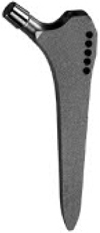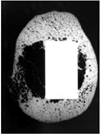Abstract
Purpose
We evaluated the usefulness of the cementless stem in treating hip fracture patients older than 70.
Materials and Methods
We studied elderly osteoporotic hip fractures in the neck and intertrochanter area who had received hip arthroplasty with over 2 years of follow up period. Among those, we analyzed the clinical and radiological results of hip arthroplasty with cemented stem (group 1) and hip arthroplasty with cementless stem (group 2). Each group was consists of fifty hips.
Results
The mean age at surgery was 75 years and mean follow-up period was 40 months (minimum 24 months). The admission period was 28.68±8.8 days for group 1 and 28.05±8.7 days for group 2 (p>0.05) and the average operation time was 87±21.2 minutes, and 80±17 minutes (p>0.05) and the total blood loss was 611±141.3 cc and 557±120.5 cc (p>0.05) respectively. There was no statistically significant difference in all aspects. One case of pulmonary embolism occurred in group 1. Stem loosening was not observed in both groups at the last follow-up radiologic study.
Figures and Tables
 | Fig. 3A 82 years old had the bipolar hemiarthroplasty with Zweymuller stem for the femur neck fracture. Radiography at post operative 4 years showed well fixation of the stem without subsidence. |
References
1. Ahnfelt L, Herberts P, Malchau H, Andersson GB. Prognosis of total hip replacement. A Swedish multicenter study of 4,664 revisions. Acta Orthop Scand Suppl. 1990. 238:1–26.
2. Brander VA, Malhotra S, Jet J, Heinemann AW, Stulberg SD. Outcome of hip and knee arthroplasty in persons aged 80 years and older. Clin Orthop Relat Res. 1997. 345:67–78.

3. Callaghan JJ, Salvati EA, Pellicci PM, Wilson PD Jr, Ranawat CS. Results of revision for mechanical failure after cemented total hip replacement, 1979 to 1982. A two to five-year follow-up. J Bone Joint Surg Am. 1985. 67:1074–1085.

4. Campbell AC, Rorabeck CH, Bourne RB, Chess D, Nott L. Thigh pain after cementless hip arthroplasty. Annoyance or ill omen. J Bone Joint Surg Br. 1992. 74:63–66.

5. Charnley J. Low friction arthroplasty of the hip. 1970. New York: Springer Verlag.
6. Cohen CA, Smith TC. The intraoperative hazard of acrylic bone cement: report of a case. Anesthesiology. 1971. 35:547–549.

7. Dandy DJ. Fat embolism following prosthetic replacement of the femoral head. Injury. 1971. 3:85–88.

8. Engh CA, Bobyn JD, Glassman AH. Porous-coated hip replacement. The factors governing bone ingrowth, stress shielding, and clinical results. J Bone Joint Surg Br. 1987. 69:45–55.

9. Engh CA, Massin P, Suthers KE. Roentgenographic assessment of the biologic fixation of porous-surfaced femoral components. Clin Orthop Relat Res. 1990. 257:107–128.

10. Gebhard JS, Amstutz HC, Zinar DM, Dorey FJ. A comparison of total hip arthroplasty and hemiarthroplasty for treatment of acute fracture of the femoral neck. Clin Orthop Relat Res. 1992. 282:123–131.

11. Gresham GA, Kuczynski A, Rosborough D. Fatal fat embolism following replacement arthroplasty for transcervical fractures of femur. Br Med J. 1971. 2:617–619.

12. Gruen TA, McNeice GM, Amstutz HC. "Modes of failure" of cemented stem-type femoral components: a radiographic analysis of loosening. Clin Orthop Relat Res. 1979. 141:17–27.
13. Haddad RJ Jr, Skalley TC, Cook SD, et al. Clinical and roentgenographic evaluation of noncemented porous-coated anatomic medullary locking (AML) and porous-coated anatomic (PCA) total hip arthroplasties. Clin Orthop Relat Res. 1990. 258:176–182.

14. Han CD, Choe WS, Shim DJ. Evaluation for cementless bipolar hemiarthroplasty for the elderly with femoral neck fracture. J Korean Hip Soc. 1997. 9:136–143.
15. Han CD, Lee WS, Yang IW. Comparison of porous coating femoral stem with HA/TPC-coated femoral stem n total hip arthroplasty. J Korean Orthop Assoc. 2000. 35:583–588.
17. Harris WH, McGann WA. Loosening of the femoral component after use of the medullary-plug cementing technique. Follow-up note with a minimum five-year follow-up. J Bone Joint Surg Am. 1986. 68:1064–1066.

18. Hungerford DS, Jones LC. The rationale for cementless total hip replacement. Orthop Clin North Am. 1993. 24:617–626.

19. Khan RJK, MacDowell A, Crossman P, Keene GS. Cemented or uncemented hemiarthroplasty for displaced intracapsular fractures of the hip--a systematic review. Injury. 2002. 33:13–17.

20. Kho DH, Kim KH, Shin JY, Lee JH, Kim DH. Postoperative mortality rate of hip fracture in elderly patients. J Korean Fract Soc. 2006. 19:117–121.

21. Kienapfel H, Sprey C, Wilke A, Griss P. Implant fixation by bone ingrowth. J Arthroplasty. 1999. 14:355–368.

22. Koval KJ, Aharonoff GB, Rosenberg AD, Bernstein RL, Zuckerman JD. Functional outcome after hip fracture. Effect of general versus regional anesthesia. Clin Orthop Relat Res. 1998. 348:37–41.
23. Lee KH, Kim SD, Lee DC, Shin DS. Experience with bipolar hemiarthroplasty in femoral neck fracture in the elderly patients: correlation between preoperative medical conditions and postoperative functional results of hip. J Korean Soc Fract. 1998. 11:143–152.

24. Mäkelä KT, Eskelinen A, Pulkkinen P, Paavolainen P, Remes V. Total hip arthroplasty for primary osteoarthritis in patients fifty-five years of age or older. An analysis of the Finnish arthroplasty registry. J Bone Joint Surg Am. 2008. 90:2160–2170.

25. Patterson BM, Healey JH, Cornell CN, Sharrock NE. Cardiac arrest during hip arthroplasty with a cemented long-stem component. A report of seven cases. J Bone Joint Surg Am. 1991. 73:271–277.

26. Parker MJ. The management of intracapsular fractures of the proximal femur. J Bone Joint Surg Br. 2000. 82:937–941.

27. Parvizi J, Holiday AD, Ereth MH, Lewallen DG. The Frank Stinchfield. Award Sudden death during primary hip arthroplasty. Clin Orthop Relat Res. 1999. 369:39–48.




 PDF
PDF ePub
ePub Citation
Citation Print
Print









 XML Download
XML Download